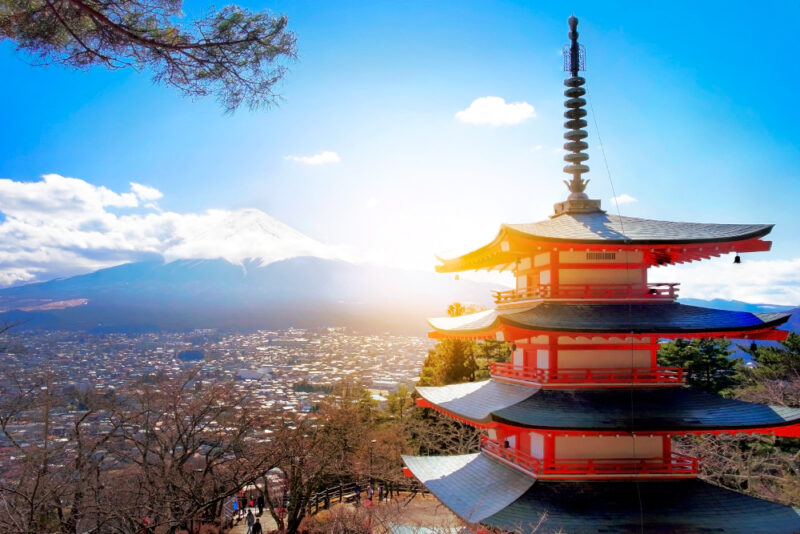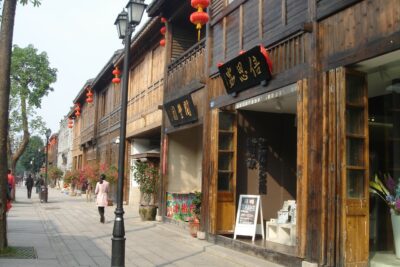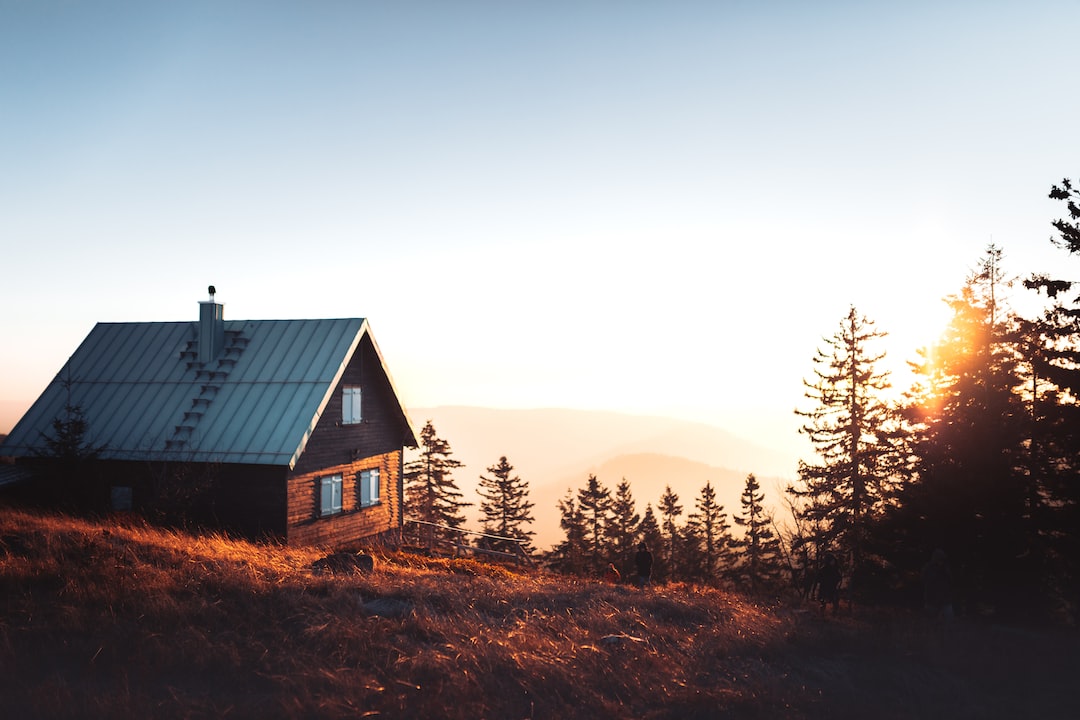Japan is blessed with remarkable natural beauty and a rich cultural heritage that draws visitors from around the world. The four distinct seasons each bring their charms and activities that make certain times of year ideal for different interests and preferences.
Tokyo dazzles year-round with its neon-lit streets, pop culture attractions, and endless dining and shopping options, making it a megacity like no other. Spring’s cherry blossom season creates stunning pink canopies across the city’s parks and gardens. Summer brings lively matsuri festivals and fireworks displays, adding to the vibrant atmosphere. Autumn paints the trees in vivid hues of red and gold. Tokyo lights up with seasonal illuminations during winter.
Kyoto, the ancient capital, showcases centuries of tradition through its temples, shrines, gardens, geisha districts, and more. Spring offers the cherry blossom season and the Aoi Matsuri festival, attracting visitors with their beauty and cultural significance. Summer sees lively Gion Matsuri celebrations. Autumn brings brilliant fall foliage and seasonal cuisine. Winter illuminates Arashiyama with Santoro light-up events.
Majestic Mount Fuji, Japan’s iconic symbol, looms over the landscape. Spring and fall offer ideal hiking conditions with moderate temperatures and clear skies. Winter transforms Fuji into a world-class ski and snowboarding destination. Summer allows one to climb above the clouds and watch the sunrise from the summit.
No matter the season, tours to Japan promise to delight the senses and create unforgettable memories for every visitor. Carefully choosing when to visit Tokyo, Kyoto, and Mount Fuji based on your interests will help craft the perfect Japanese experience.
Overview of Japan’s Four Distinct Seasons
One of the coolest things about Japan is that you get to have different awesome experiences depending on the time of year you visit.
During springtime, cherry blossom trees bloom everywhere, adding a pretty pink hue to the scenery. It’s nice to have a picnic or take a walk under the blooming sakura trees.
Summer is hot and sticky – perfect for chilling at the beach, cheering at summer festivals with all the fireworks, and splashing around doing water sports.
Fall is just gorgeous ’cause the leaves on all the trees turn into incredible shades of red, orange, and yellow. It’s lovely to stroll around and take in all those colorful leaves.
During wintertime, some parts of Japan are blanketed with snow. So, you can go skiing down the slopes or snowboarding on the magnificent mountains. Afterward, cozy up with a steamy bowl of ramen to warm up! And don’t forget, you can also plan tours to Japan based on what you want to see and do during that season. That way, you can make the absolute most out of your visit to Japan!
When is the Best Time to Visit Tokyo?
Tokyo offers beautiful scenery and cultural events across all four seasons. However, spring and autumn are considered the best times for tourists.
Spring in Tokyo (Late March to Early April)
Tokyo transforms into a pink wonderland every spring, boasting over 1,000 cherry blossom viewing spots. The Yoshino cherry trees first bloom in late March in Tokyo’s parks and gardens, with full bloom typically occurring in early April.
Popular hanami spots include Ueno Park (with over 1,000 cherry trees), Shinjuku Gyoen (housing over 1,500 trees), and the Meguro River where rows of cherry trees form a canopy overhead. During the peak bloom period, millions flock to participate in hanami, the Japanese tradition of cherry blossom viewing.
Visitors can attend vibrant festivals showcasing traditional performances, sample Sakura-infused cuisine and beverages, and participate in bento picnics under the trees. Key highlights of spring include
- Picture-perfect scenes of fluffy pink sakura set against Tokyo’s skyscrapers
- Hanami festivals like Ueno Sakura Matsuri with live music, dance, and entertainment
- Food stalls selling sakura-flavored sweets, desserts and sake
- Renting a boat or kayak to enjoy Meguro River’s 800 cherry trees from the water
The mild spring weather, with average temperatures of 13°C, creates ideal conditions for strolls through blooming parks and gardens. Though the actual peak is short-lived, usually lasting about a week or two in early April, Tokyo’s long bloom season from late March to early May allows flexibility in planning your visit.
Autumn in Tokyo (October to November)
Tokyo shines with stunning fall colors in November when trees turn vibrant hues of red, orange, and yellow. Top spots to see peak foliage include Shinjuku Gyoen, Rikugien Garden, Meiji Jingu Shrine, and Mount Takao. Pleasant weather with average temperatures around 18°C makes autumn perfect for strolling through Tokyo’s parks and gardens. Popular activities include:
- Walking through tree tunnels of vibrant fall colors
- Visiting shrines like Meiji Jingu during Autumn Grand Festivals
- Sampling seasonal delicacies like sweet potato tempura and chestnut confections
- Take the cable car up Mount Takao for panoramic foliage views
The cooling temperatures also make it perfect for outdoor festivals, known as matsuri, which attract visitors from far and wide. Key autumn matsuri in Tokyo include the Meiji Jingu Autumn Grand Festival, Asakusa Samba Carnival, and Tokyo International Film Festival. With less rainfall and smaller crowds compared to spring, Tokyo’s autumn season appeals to those seeking culture, serenity, and comfortable weather while touring.
When is the Best Time to Visit Kyoto?
Kyoto showcases elegant cherry blossoms in spring as well as breathtaking fall colors. Its cultural legacy beckons history aficionados.
Spring in Kyoto (Late March to Early April)
Kyoto transforms into a pink wonderland as its 1600+ cherry trees, including Yoshino cherries, burst into bloom. Popular spots include Maruyama Park, the Path of Philosophy, and Heian Shrine. Enjoy hanami, visit temples, and experience traditional tea ceremonies.
Take a stroll down Kyoto’s picturesque Philosopher’s Path
Key highlights:
- Riverside hanami at Kamo River
- Temple hopping to admire Sakura
- Delicate wagashi (sweets) and green tea
Autumn in Kyoto (November)
With brilliant maple trees, Kyoto’s fall foliage is legendary. For the best views head to Arashiyama, Ginkakuji, and Tofukuji Temple. Crisp air, striking autumn hues, and minimal crowds create an ideal ambiance for peaceful contemplation and meditation.
Fall colors frame a temple gate against the backdrop of mountains.
Key highlights:
- Instagrammable scenes at bamboo groves and temples
- Spiritual strolls through peaceful gardens
- Kaiseki cuisine with seasonal ingredients
When is the Best Time to Visit Mount Fuji?
Mount Fuji can be visited year-round, but the climbing season and viewing seasons offer distinct highlights.
Summer Mount Fuji Climbing Season (July to mid-September)
The official climbing season on Mount Fuji is from July 1 to September 10, which aligns with peak summer weather and trail accessibility. This is the only time hikers with proper fitness and gear can summit the 3,776-meter mountain. The Yoshida Trail is the most popular, taking 5-7 hours for the ascent and 3-5 hours hiking down. Bus transport is available to the trailhead. Key tips include:
- Bring proper hiking gear and clothing and start early to allow sufficient daylight
- Take advantage of mountain huts for meals, water, and rest during the climb
- Time your ascent to witness the sunrise from the summit
While physically challenging, reaching Mt. Fuji’s summit during the climbing season is an unforgettable experience.
Year-Round Fuji Viewing Seasons
Outside the climbing season, one can still admire Mount Fuji’s majestic beauty from various viewpoints around the region. Some top spots include
Winter: Lake Kawaguchi’s northern shore captures Fuji in its snow-capped glory.
Spring: Chureito Pagoda framing a picture-perfect view of Fuji with cherry blossoms.
Summer: Gotemba Premium Outlets with Mount Fuji in the background.
Autumn: Majestic autumn colors surrounding Fuji within the Fuji Five Lakes region.
Even if you miss the climbing season, Mount Fuji’s stunning allure can be appreciated year-round by visiting on days with good visibility.
By expanding these sections, readers get a more comprehensive overview specifying the attractions, activities, tips, and highlights associated with the best seasons for visiting Tokyo and Mount Fuji. The additional details help travelers determine the ideal timing for their trips based on preferences.
Conclusion
Tokyo, Kyoto, and Mount Fuji showcase stunning seasonal transitions. While spring and autumn are peak travel seasons, visiting during off-peak months allows you to avoid crowds. Consider your interests, time constraints, and these suggestions to determine the ideal time for visiting Japan’s top destinations.
For an unforgettable Japan trip, tactfully choose when is the best season for touring Tokyo, Kyoto, and majestic Mount Fuji by aligning with your travel preferences. The experiences and memories will last a lifetime!
Frequently Asked Questions
How can I avoid crowds in Tokyo and Kyoto?
Try to aim for weekdays if possible. For cherry blossom season, mornings are less crowded. Visit famous sites either in the early morning or late afternoon. Off-season months like May, September, and November typically see fewer tourists.
What’s the ideal itinerary to visit all three destinations efficiently?
A 10-12-day itinerary allows sufficient time. Recommended route:
Tokyo (4 days) > Hakone & Mount Fuji (2 days) > Kyoto (4 days)
What are the key events I should consider when planning my trip?
In Tokyo: Cherry Blossom Festivals (early April) and Sanja Matsuri (late May) are key events to note.
In Kyoto: Aoi Matsuri Festival (early May), Gion Matsuri (July), and fall foliage season (November).









